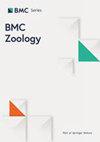Lions & sea lions & bears, oh my: utilizing museum specimens to study the ossification sequence of carnivoran taxa
IF 1.7
3区 生物学
Q2 ZOOLOGY
引用次数: 0
Abstract
Mammalian skeletons are largely formed before birth. Heterochronic changes in skeletal formation can be investigated by comparing the order of ossification for different elements of the skeleton. Due to the challenge of collecting prenatal specimens in viviparous taxa, opportunistically collected museum specimens provide the best material for studying prenatal skeletal development across many mammalian species. Previous studies have investigated ossification sequence in a range of mammalian species, but little is known about the pattern of bone formation in Carnivora. Carnivorans have diverse ecologies, diets, and biomechanical specializations and are well-suited for investigating questions in evolutionary biology. Currently, developmental data on carnivorans is largely limited to domesticated species. To expand available data on carnivoran skeletal development, we used micro-computed tomography (micro-CT) to non-invasively evaluate the degree of ossification in all prenatal carnivoran specimens housed in the Harvard Museum of Comparative Zoology. By coding the presence or absence of bones in each specimen, we constructed ossification sequences for each species. Parsimov-based genetic inference (PGi) was then used to identify heterochronic shifts between carnivoran lineages and reconstruct the ancestral ossification sequence of Carnivora. We used micro-CT to study prenatal ossification sequence in six carnivora species: Eumetopias jubatus (Steller sea lion, n = 6), Herpestes javanicus (small Indian mongoose, n = 1), Panthera leo (lion, n = 1), Urocyon cinereoargenteus (gray fox, n = 1), Ursus arctos arctos (Eurasian brown bear, n = 1), and Viverricula indica (small Indian civet, n = 5). Due to the relatively later stage of collection for the available specimens, few heterochronic shifts were identified. Ossification sequences of feliform species showed complete agreement with the domestic cat. In caniforms, the bear and fox ossification sequences largely matched the dog, but numerous heterochronic shifts were identified in the sea lion. We use museum specimens to generate cranial and postcranial micro-CT data on six species split between the two major carnivoran clades: Caniformia and Feliformia. Our data suggest that the ossification sequence of domestic dogs and cats are likely good models for terrestrial caniforms and feliforms, respectively, but not pinnipeds.狮子、海狮和熊,哦,我的:利用博物馆标本研究食肉动物类群的骨化序列
哺乳动物的骨骼大多在出生前形成。通过比较不同骨骼元素的骨化顺序,可以研究骨骼形成的异时变化。由于在胎生类群中收集产前标本是一项挑战,因此在许多哺乳动物物种中,偶然收集到的博物馆标本为研究产前骨骼发育提供了最佳材料。以前的研究已经调查了一系列哺乳动物物种的骨化序列,但对食肉目动物的骨骼形成模式知之甚少。食肉动物的生态、饮食和生物力学特性多种多样,非常适合研究进化生物学方面的问题。目前,食肉动物的发育数据主要局限于驯化物种。为了扩展食肉动物骨骼发育的现有数据,我们使用微型计算机断层扫描(micro-CT)技术对哈佛大学比较动物学博物馆收藏的所有食肉动物产前标本的骨化程度进行了非侵入式评估。通过对每个标本中是否存在骨骼进行编码,我们构建了每个物种的骨化序列。然后,我们利用基于帕西莫夫的遗传推断(PGi)来确定食肉目动物各系之间的异时转移,并重建食肉目动物的祖先骨化序列。我们使用显微 CT 技术研究了六种食肉动物的产前骨化序列:它们是:Eumetopias jubatus(斯特勒海狮,n = 6)、Herpestes javanicus(小印度獴,n = 1)、Panthera leo(狮子,n = 1)、Urocyon cinereoargenteus(灰狐,n = 1)、Ursus arctos arctos(欧亚棕熊,n = 1)和Viverricula indica(小印度果子狸,n = 5)。由于现有标本的采集时间相对较晚,因此几乎没有发现异时变种。猫科动物的骨化序列与家猫完全一致。在犬科动物中,熊和狐的骨化序列与狗基本吻合,但在海狮中发现了许多异时变异。我们利用博物馆标本生成了分属两大食肉动物支系的六个物种的颅骨和颅后显微 CT 数据:犬形目和鼬形目。我们的数据表明,家犬和家猫的骨化序列很可能分别是陆生犬形目和猫形目动物的良好模型,但不包括针足类动物。
本文章由计算机程序翻译,如有差异,请以英文原文为准。
求助全文
约1分钟内获得全文
求助全文
来源期刊

BMC Zoology
Agricultural and Biological Sciences-Animal Science and Zoology
CiteScore
2.30
自引率
6.20%
发文量
53
审稿时长
24 weeks
期刊介绍:
BMC Zoology is an open access, peer-reviewed journal that considers articles on all aspects of zoology, including physiology, mechanistic and functional studies, anatomy, life history, behavior, signalling and communication, cognition, parasitism, taxonomy and conservation.
 求助内容:
求助内容: 应助结果提醒方式:
应助结果提醒方式:


